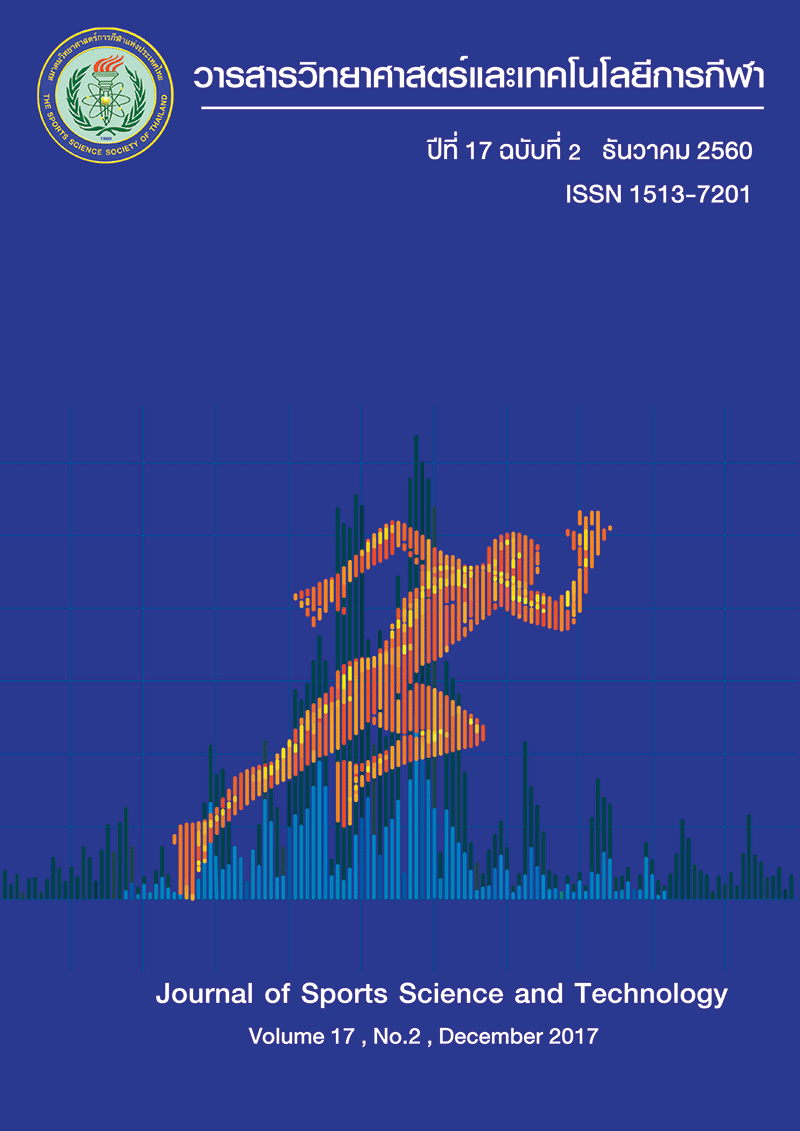EFFECTS OF A NEWLY DESIGNED MILITARY SHIRT ON PHYSIOLOGICAL RESPONSES UNDER HEAT STRESS
Keywords:
Battle dress uniform / heat exchange / thermoregulation / physiological strainAbstract
The operations of military forces require wearing battle dress uniform and a protective ballistic vest which may increase physiological strain and impair physical performance in hot and humid environment. Objective: to investigate and compare the effects of two military shirts; a newly designed long-sleeved military shirt (NMS) and a traditional military shirt (CON) on physiological responses, time to exhaustion (TTE), and subjective perception during exercise in hot and humid condition (NMS; 35.3 ± 0.1๐C, 50.6 ± 1.2%, CON; 35.1 ± 0.2๐C, 50.7 ± 0.8%). Method: Twelve healthy and physically active males (Age: 20.8 ± 0.4 years; BW: 66.6 ± 1.7 kg; Height: 173.6 ± 1.6 cm) volunteered to participate in this study. Subjects completed two experimental trials wearing NMS or CON covered by the standard military protective vest in a randomized order. Subjects walked on a motorized treadmill (3.5 km/h, 0% grade), wear a combat helmet and carry mission load including rifle and back pack over 120 minutes or until exhaustion. Core temperatures (TGI), Skin temperatures, stroke volume (SV), cardiac output (CO), oxygen consumption rate (VO2), rating of perceived exertion (RPE), and thermal responses were measured at rest and every 5 minutes during exercise. Two-way repeated measurement ANOVA was used to test the main effects of shirts and times, and interaction effect. Paired t-test and Wilcoxon signed rank test were applied for sweat loss, time to exhaustion and thermal subjective responses, respectively. Results: no main effect of shirts and interaction effects of shirts and time on core temperature and skin temperature, HR, VO2, SV, and RPE were observed. Moreover, TTE and thermal responses of NMS and CON trials were not significantly different. However, CO at the end of exercise of CON (18.0 ± 0.5 L.min-1) and NMS (16.6 ± 0.45 L.min-1) was significantly different.Conclusion: Wearing NMS beneath a protective vest during exercise in hot, humid environment did not exert any different effects on time to exhaustion, physiological responses, and subjective perception when compared to CON. It is possible that a protective vest that covered the military shirt may impede the effectiveness of NMS on heat transfer.
(Journal of Sports Science and Technology 2017; 17(2): 97-108)
Keywords: Battle dress uniform / heat exchange / thermoregulation / physiological strain
*Corresponding author: Metta PINTHONG
College of Sports Science Technology, Mahidol University,
NakhonPathom, Thailand 73170
E-mail: Metta.pin@mahidol.edu
References
2. Occupational Safety and Health Administration. OSHA technical manual (TED 1-0.15A), section III chapter 4-heat stress 1999 [Retrieved March 15, 2001]. Available from: www.osha-slc.gov/dts/osta/otm_III/otm_iii_4.html.
3. Gisolfi CV, Mora F. The Hot brain: Survival, temperature and the human body. Massachusetts: MIT Press Journal 2000; 1-13.
4. Dai XQ, Imamura R, Liu GL, Zhou FP. Effect of moisture transport on microclimate under T-shirt. Eur J App Physiol 2008; 104(2):337-40.
5. Nadel ER, Stolwijk A. Effect of skin wettedness on swat gland response. J App Physiol 1973; 35:689-94.
6. Gavin TP, Babington JP, Harms CA, Ardelt ME, Tanner DA, Stager JM. Clothing fabric does not affect thermoregulation during exercise in moderate heat. Med Sci Sports Exerc 2001; 33(12):2124-30.
7. Brazaitis M, Kamandulis S, Albertas S, Daniuseviciute L. The effect of two kinds of t-shirts on physiological and psychological Thermal responses during exercise and recovery. Appl Ergon 2010; 42(1):46-51.
8. Laing RM., Sims ST, Wilson BE. Difference in wearer response to garments for outdoor activity. Ergonomics 2008; 51:492-510.
9. Cadarette B, Chinevere T, Goodman D, Laprise B, Teal W, Sawka M. Physiological responses to exercise-heat stress with prototype pulsed microclimate cooling system. Defense Technical Information Center 2008. Available from: http://www.dtic.mil/dtic/tr/fulltext/u2/a487097 .pdf;accessed July 9, 2013.
10. Chinevere T, Cadarette B, Goodman D, Ely B, Cheuvront S, Sawka M. Efficacy of body ventilation system for reducing strain in warm and hot climates. Eur J App Physiol 2008; 103(3): 307-14.
11. Scheider S, Roberg R, Verney S, Amorim F, Yamada P. Effect of palm cooling with negative pressure on heat balance during exercise in a hot, dry environment. Research Triangle Park, NC, Defense Technical Information Center. 2006. Available from: http://www.dtic.mil/cgi-bin/GetTRDoc?AD=ADA459500.
12. Hadid A, Yanovich R, Erlich T, Khomenok G, Moran D. Effect of a personal ambient ventilation system on physiological strain during heat stress wearing a ballistic vest. Eur J App Physiol 2008; 104:311-9.
13. Adams JD, McDermott BP, Ridings CB, Mainer LL, Ganio MS, Kavouras SA. Effect of air-filled vest on exercise-heat strain when wearing ballistic protection. Ann Occup Hyg 2014; 58(8):1057-64.
14. Byrne C and Lim CL. The ingestible telemetric body core temperature sensor: a review of validity and exercise applications. Br J Sports Med 2007; 41(3):126-33.
15. Cheuvront S, Goodman D, Ke netfick R, Montain S, and Sawka M. Impact of a protective vest and spacer garment on exercise-heat strain. Eur J App Physiol 2008; 102:577-83.
16. Cadarette BS, Blanchard L, Staab JE, Kolka MA, and Sawka MN. Heat stress when wearing body armor. US Army Research Institute of Environmental Medicine. 2001;T-01/9, Natick.
17. Bouskill LM, Havenith G, Kuklane K, Parsons KC, Withey WR.Relationship between clothing ventilation and thermal insulation. AIHA J 2002; 63(3):262-8.
18. Moran DS, Shitzer A, Pandolf KB. A physiological strain index to evaluate heat stress. Am J Physiol 1998; 275(1 Pt 2):R129-34.
19. Gonzalez-Alonso J, Crandall CG, Johnson JM. The cardiovascular challenge of exercising in the heat. J Physiol 2008; 586(1):45-53.
20. Hargreaves M. Physiological limits to exercise performance in the heat. J Sci Med Sport 2008; 77(1):66-71.
21. Armada-da-Silva PA, Woods J, Jones DA. The effect of passive heating and face cooling on perceived exertion during exercise in the heat. Eur J App Physiol 2004; 91:563-71.
22. Coyle EF and Gonzalez-Alonso J. Cardiovascular drift during prolonged exercise: New perspective. Exerc Sport Sci Rev 2001; 29:88-92.
23. Borg G. Borg’s perceived exertion and pain scales. Champaign: human kinetics. 1998. 24. Zhang Y, Wyon DP, Fang L, and Melikov AK. The influence of heated or cooled seats on the acceptable ambient temperature range. Ergonomics 2007; 50(4):586-600.






